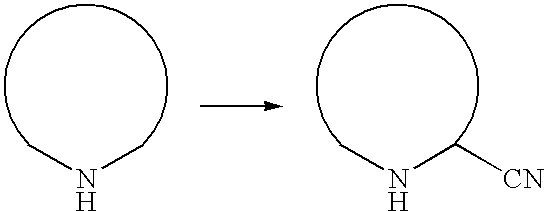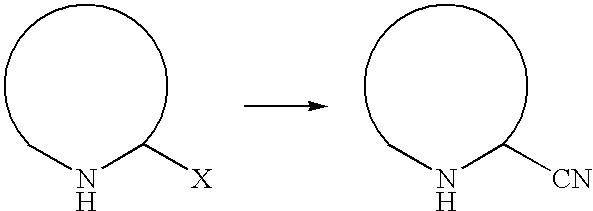Process for the preparation of cyano-substituted-nitrogen-containing heteroaryl compounds
a technology of cyanosubstituted nitrogen and heteroaryl compounds, which is applied in the field of synthesis of cyanosubstituted nitrogen containing heteroaryl compounds, can solve the problems of toxicity of starting materials, difficult to produce molecules on a large scale by known synthetic methods, and not been commercialized, and achieves high yield, high purity, and reliable preparation
- Summary
- Abstract
- Description
- Claims
- Application Information
AI Technical Summary
Benefits of technology
Problems solved by technology
Method used
Image
Examples
example 1-2
A. Example 1-2
[0097]These examples illustrate comparative preparations of 3-CNT.
1. Preparation of 3-CNT by Cyclization of Cyanoformimidic Acid Hydrazide with Triethylorthoformate
[0098]Cyanoformimidic acid hydrazide was prepared in 53-62% yield from cyanogen and anhydrous hydrazine followed the procedure described in U.S. Pat. No. 3,004,060.
[0099]3-CNT was prepared based on the procedure described in U.S. Pat. No. 3,927,216: In a 250 ml flask fitted with a mechanical stirrer, a temp probe, a cooling bath, and a positive nitrogen set up was placed with cyanoformimidic acid hydrazide 15.0 gm (0.178 mole) and triethyl orthoformate 80.2 gm (0.541 mole). The mixture was chilled to 0-5° C. A 4 gm solution of dioxane which was pre-saturated with HCl gas was added in one portion. The reaction mixture was stirred at 0-5° C. for 5 hours, warmed to ambient temperature, and stirred at ambient temperature until reaction completion (<0.5 area % cyanoformimidic acid hydrazide by HPLC). After reacti...
examples 3-6
B. Examples 3-6
[0101]These examples illustrate the preparation of 3-CNT using the dehydration methods of the present invention.
3. Preparation of 3-CNT by Dehydration with SOCl2
[0102]In a 250 ml flask equipped with a mechanical stirrer, a temp probe, a cooling bath and a positive nitrogen set up was placed with 1,2,4-triazloe-3-carboxamide (22.4 gm, 0.20 mole) and acetonitrile 100 ml. The mixture was chilled in an ice water bath. 4-methylmorpholine 56.6 gm (0.56 mole) was added in one portion. Thionyl chloride 47.8 gm (0.40 mole) was added in 2 hours at 5-17° C. Then the mixture was warmed to ambient temperature. Dimethylformamide 3.7 gm (0.051 mole) was added. The mixture was continued to stir at ambient temperature for additional 4 hours. Then the mixture was chilled in an ice water bath before water quench. Water 60 ml was added at 15-34° C. The mixture was extracted with 5×60 ml ethyl acetate. The combined ethyl acetate layer was washed with 2×20 ml 9% NaCl solution and concentr...
example 6
C. Example 6
[0108]These examples illustrate the preparation of 4-cyanoimidazole using the dehydration methods of the present invention.
6. Preparation of 4-Cyanoimidazole
[0109]In a dried 125 mL, three-neck flask fitted with a magnetic stirrer, temperature probe, a reflux condenser, and a positive nitrogen atmosphere set-up was charged with 4-imidazole carboxamide 2.0 gm (18 mmol), acetonitrile 25 ml, and POCl3 6.6 gm (43.2 mmol). The brown slurry was agitated and heated to reflux. The reaction mixture was maintained at reflux for at least 15 hrs. Then the excess POCl3 was distilled under reduced pressure. After aqueous work up, the reaction mixture was adjusted to a pH of 9-11 using 25% sodium hydroxide, and extracted with 4×70 ml ethyl acetate. The combine ethyl acetate extracts were treated with 20 gm silica gel, distilled under pressure to remove ethyl acetate and to afford 4-cyanoimidazole as a white solid. After drying the 4-cyanoimidazole weighed 1.1 gm (65.9% yield): HPLC puri...
PUM
| Property | Measurement | Unit |
|---|---|---|
| temperature | aaaaa | aaaaa |
| temperatures | aaaaa | aaaaa |
| concentration | aaaaa | aaaaa |
Abstract
Description
Claims
Application Information
 Login to View More
Login to View More - R&D
- Intellectual Property
- Life Sciences
- Materials
- Tech Scout
- Unparalleled Data Quality
- Higher Quality Content
- 60% Fewer Hallucinations
Browse by: Latest US Patents, China's latest patents, Technical Efficacy Thesaurus, Application Domain, Technology Topic, Popular Technical Reports.
© 2025 PatSnap. All rights reserved.Legal|Privacy policy|Modern Slavery Act Transparency Statement|Sitemap|About US| Contact US: help@patsnap.com



